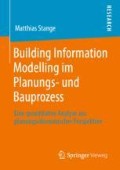Zusammenfassung
In der öffentlichen Debatte besteht ein kontroverses Meinungsbild in Bezug auf den Einfluss der BIM-Methode auf die Steigerung der Produktivität im Planungs- und Bauprozess. Insbesondere die Quantifizierung von projektphasenübergreifenden und anwenderbezogenen Vorteilen der Anwendung von BIM sowie mögliche Wechselwirkungen sind bisher nicht vollständig erforscht. Zwar gibt es inzwischen zahlreiche qualitative Studien und einige wenige quantitative Studien, jedoch konzentrieren diese sich ausschließlich auf lokale Fallbeispiele mit kleiner Stichprobengröße.
Access this chapter
Tax calculation will be finalised at checkout
Purchases are for personal use only
Preview
Unable to display preview. Download preview PDF.
Author information
Authors and Affiliations
Corresponding author
Rights and permissions
Copyright information
© 2020 Springer Fachmedien Wiesbaden GmbH, ein Teil von Springer Nature
About this chapter
Cite this chapter
Stange, M. (2020). Empirischer Teil. In: Building Information Modelling im Planungs- und Bauprozess. Springer Vieweg, Wiesbaden. https://doi.org/10.1007/978-3-658-29838-8_6
Download citation
DOI: https://doi.org/10.1007/978-3-658-29838-8_6
Published:
Publisher Name: Springer Vieweg, Wiesbaden
Print ISBN: 978-3-658-29837-1
Online ISBN: 978-3-658-29838-8
eBook Packages: Computer Science and Engineering (German Language)

